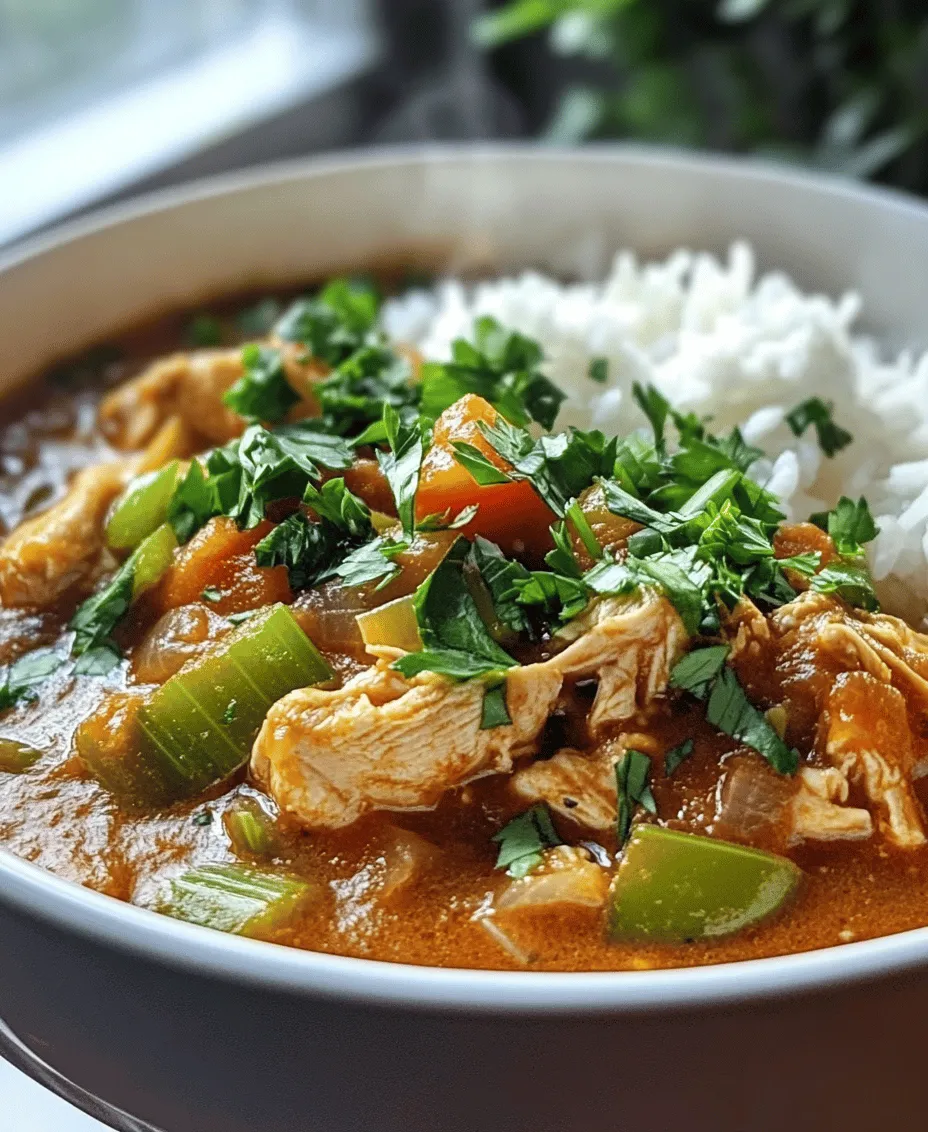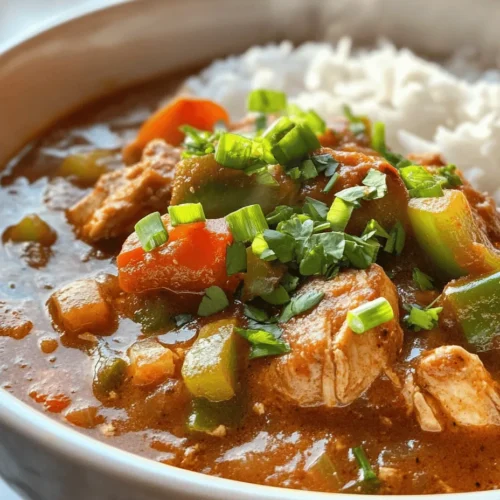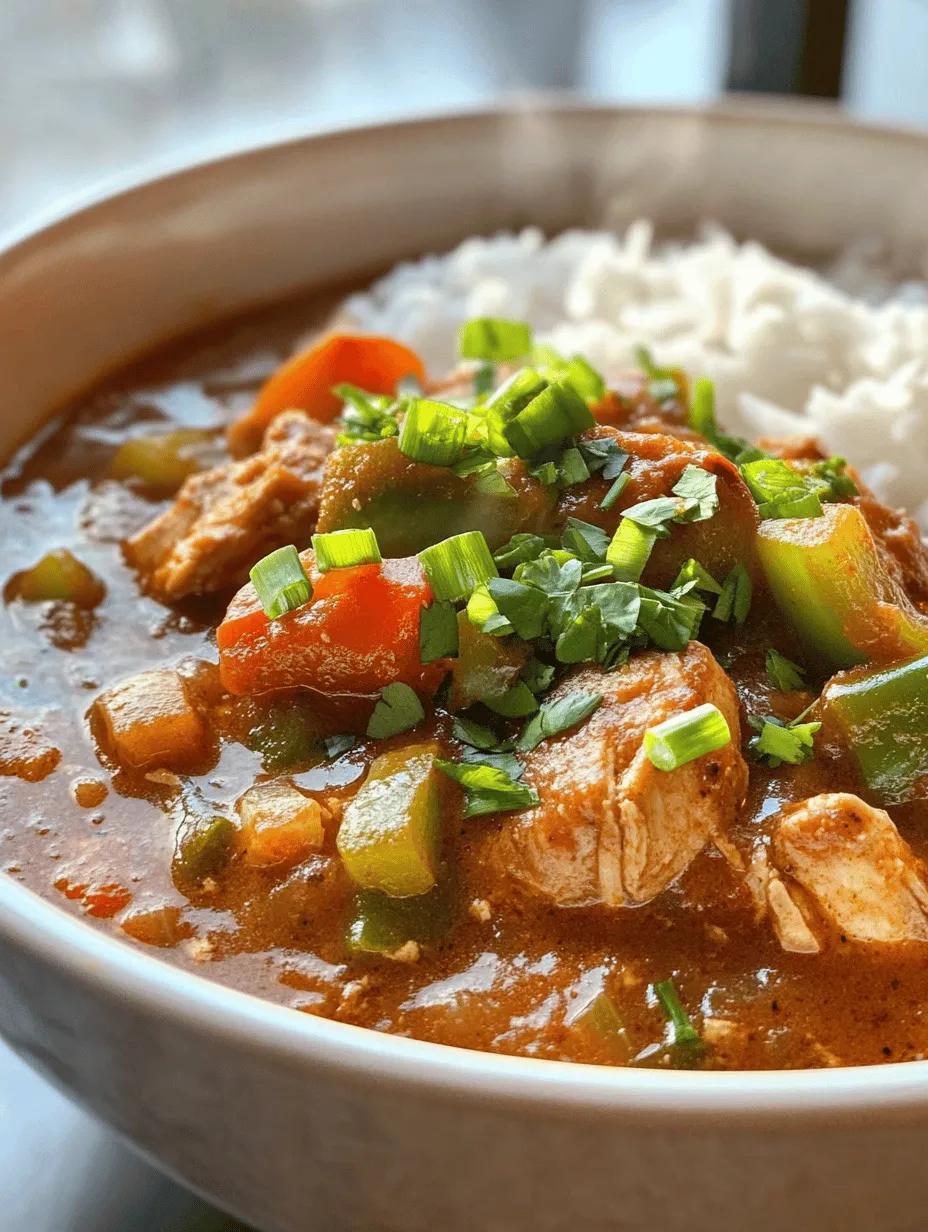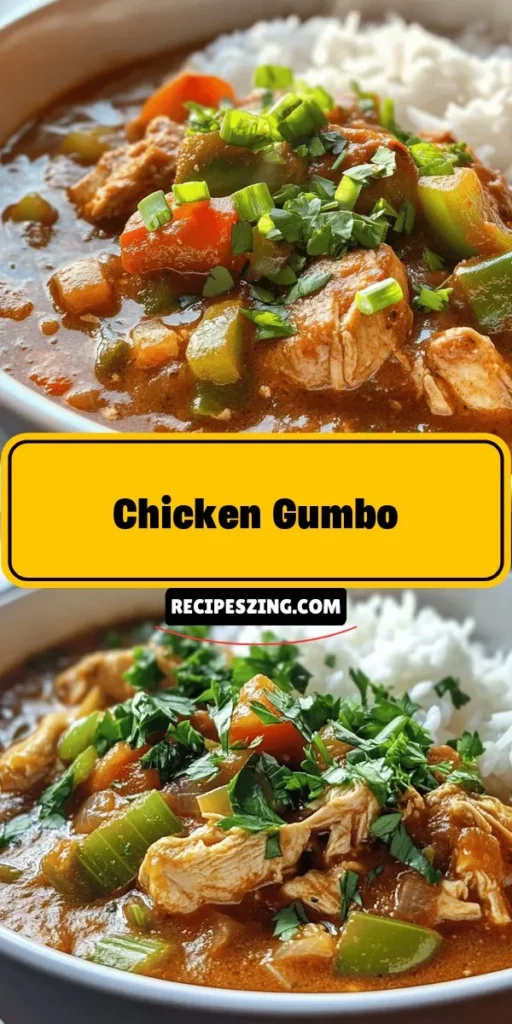Introduction
Gumbo is not just a dish; it’s a celebration of Southern cuisine, steeped in history and bursting with flavor. Originating from the vibrant culture of Louisiana, this hearty stew is a testament to the melting pot of influences that have shaped Southern cooking. With roots tracing back to West African, French, and Spanish culinary traditions, gumbo embodies the spirit of community, comfort, and creativity in cooking.
The importance of gumbo extends beyond its taste; it represents a way of life for many in the South. Whether served at family gatherings, festive occasions, or quiet dinners, gumbo brings people together around the table, fostering connection and conversation. Its rich, savory broth and diverse ingredients reflect the cultural tapestry of Louisiana, making it a beloved staple in homes and restaurants alike.
In this article, we will delve into a specific variant of this classic dish: Spicy & Savory Chicken Gumbo. This recipe offers a delightful combination of spices and textures that will tantalize your taste buds. Featuring tender chicken, a medley of vegetables, and a robust roux, this gumbo is perfect for those who crave warmth and comfort in every bowl. Its flavor profile is a harmonious balance of spicy and savory, appealing to food lovers who appreciate depth and complexity in their meals.
Understanding Gumbo
Historical Background of Gumbo
The history of gumbo is as

Spicy & Savory Chicken Gumbo: A Culinary Delight
Mastering the Roux
The heart of any great gumbo lies in its roux. This essential mixture of flour and fat is not only a thickening agent but also adds a rich, nutty flavor that defines the dish. To prepare the roux for your Spicy & Savory Chicken Gumbo, start by choosing the right fat. Traditionally, oil or butter works well, but some chefs prefer using a combination of both for added depth.
1. Heat the Fat: In a heavy-bottomed pot or Dutch oven, heat ½ cup of oil (vegetable or canola) over medium heat. The key here is to not rush; a low and slow approach ensures an even color and prevents burning.
2. Add the Flour: Gradually whisk in ½ cup of all-purpose flour, stirring constantly. The roux will start to bubble and thicken.
3. Achieving Color: Continue to cook the roux, stirring constantly for about 20-30 minutes. The color should transition from pale yellow to a rich chocolate brown. A darker roux imparts deeper flavor, but be careful not to burn it—once it reaches a burnt texture, it cannot be salvaged.
Common Mistakes to Avoid While Making Roux
– Rushing the Process: Cooking the roux too quickly over high heat can lead to burning. Patience is key.
– Inadequate Stirring: Neglecting to stir continuously can result in uneven cooking and scorching.
– Ignoring the Aroma: Pay attention to the smell; when the roux starts to emit a nutty aroma, it’s getting close to the perfect color.
With your roux perfected, it’s time to enhance the flavor profile of your gumbo.
Sautéing the Holy Trinity
The “holy trinity” of Cajun and Creole cooking consists of onions, bell peppers, and celery. This aromatic trio forms the flavorful backbone of your gumbo.
1. Sauté the Vegetables: After your roux reaches the desired color, add 1 cup each of finely chopped onions, bell peppers, and celery. Stir and cook for about 5-7 minutes until the vegetables soften and begin to caramelize slightly.
2. Impact on Flavor: Sautéing the holy trinity in the roux not only infuses the vegetables with its rich flavor but also adds layers to the gumbo’s overall taste. This step is crucial as it builds the foundation of flavor for the entire dish.
Incorporating Chicken: Tips for Even Cooking
Adding chicken to your gumbo requires attention to ensure it cooks evenly and remains juicy.
1. Choose the Right Cut: Opt for skinless, boneless chicken thighs for a tender and flavorful result. Dice the chicken into bite-sized pieces for uniform cooking.
2. Searing the Chicken: Before adding the chicken to the gumbo, consider searing it in the pot after the vegetables. This adds a caramelized flavor to the chicken, enhancing the overall taste of your gumbo.
3. Cooking Method: Once the chicken is added, stir it into the roux and sauté for about 5 minutes, allowing it to brown slightly before adding the broth. This helps lock in moisture and flavor.
Adding the Remaining Ingredients: Layering of Flavors
Now that your roux, holy trinity, and chicken are combined, it’s time to build the rest of the gumbo.
1. Incorporate Broth: Pour in 6 cups of chicken stock or broth, scraping any brown bits from the bottom of the pot. This adds depth and flavor to your gumbo.
2. Spices and Seasoning: Stir in 2 teaspoons of Cajun seasoning, 1 teaspoon of dried thyme, and 1 teaspoon of salt. Adjust these according to your taste preferences. You can also add a pinch of cayenne pepper for an extra kick.
3. Adding Sausage and Seafood: If you want to include andouille sausage or shrimp, add them towards the end of cooking to avoid overcooking. Sausage should be added after the broth, while shrimp can be added during the last 5 minutes of simmering.
The Importance of Simmering
Simmering is crucial for developing the flavors and achieving the right texture in your gumbo.
1. Simmering Process: Bring the mixture to a boil, then reduce the heat to low and let it simmer uncovered for at least 45 minutes to 1 hour, stirring occasionally. This allows the flavors to meld beautifully.
2. Texture and Taste: As the gumbo simmers, it will thicken and the flavors will deepen. The chicken will become tender, and the spices will infuse the broth, creating a harmonious blend.
Cooking Tips for Perfect Gumbo
1. Adjusting Spice Levels: Taste your gumbo as it cooks. If you prefer a milder flavor, reduce the amount of cayenne pepper or use a mild sausage. For heat lovers, feel free to add more spices or even hot sauce at the end.
2. Recommended Cooking Equipment: A heavy-bottomed pot or Dutch oven is ideal for making gumbo, as it distributes heat evenly. A wooden spoon or silicone spatula is perfect for stirring.
3. Significance of Simmering Time: Longer simmering times enhance flavor, but be mindful of your ingredients. If using shrimp, add them during the last few minutes to keep them tender.
Serving Suggestions: Pairing with Sides and Garnishes
Gumbo is a hearty dish that pairs well with various sides and garnishes.
1. Rice: Serve over a bed of white rice or brown rice to balance the rich flavors of the gumbo. The rice absorbs the broth, making every bite delightful.
2. Garnishes: Add fresh chopped parsley or green onions for a pop of color and freshness. A squeeze of lemon can also brighten the flavors.
3. Accompaniments: Consider serving with crusty French bread or cornbread to soak up the delicious broth.
Nutritional Information
Understanding the nutritional benefits of the ingredients in your gumbo can help you enjoy it as a balanced meal.
1. Nutritional Overview: Chicken provides lean protein, while the holy trinity (onions, bell peppers, celery) adds vitamins A, C, and K, along with fiber. Cajun spices often include herbs that have antioxidant properties.
2. Portion Sizes: A typical serving of gumbo is about 1-1.5 cups, which can contain approximately 300-400 calories, depending on the ingredients used. Adjust portion sizes to fit your dietary needs.
3. Balanced Meal: By serving gumbo with rice and a side salad, you can create a well-rounded meal that includes protein, carbohydrates, and plenty of vegetables.
Conclusion
Spicy & Savory Chicken Gumbo is not just a dish; it’s an experience that brings warmth and comfort to the table. With its rich flavors, hearty ingredients, and endless variations, gumbo is a versatile meal that can suit any occasion.
Don’t hesitate to experiment with the recipe—add your favorite proteins, adjust the heat level, or incorporate seasonal vegetables. Cooking is about creativity and sharing delicious moments with loved ones, so make this gumbo your own! Enjoy the process, savor the results, and share the joy of cooking with family and friends.



